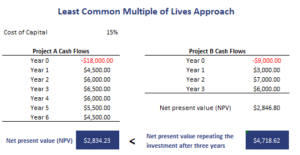Least Common Multiple of Lives Approach
The Least Common Multiple of Lives approach is a method to evaluate capital projects that are mutually exclusive and that have unequal lives. Another method to evaluate capital projects with unequal lives is the equivalent annual annuity (EEA) approach.
On this page, we discuss the least common multiple of lives approach. We discuss the definition and the steps involved. A least common multiple of lives approach Excel spreadsheet is available at the bottom of the page.
Least Common Multiple of Lives definition
When we have two mutually exclusive projects, it means that the company can only choose one of the two projects. In case both projects have different lives, it is not possible to compare them directly. Instead, we have to make an adjustment first. The least common multiple approach is one such adjustment.
In particular, what we will do is we create a so-called replacement chain. That’s why the approach is also sometimes called the replacement chain method. This means that we repeat the investment of the project with the shortest lifespan a number of times until it matches the lifespan of the project with the longer lifespan.
Least Common Multiple of Lives approach example
Let’s consider an example to make things more clear. Let’s assume we have two projects. The first project has a useful life of 6 years, the second project only has a useful life of only 3 years. Thus, we are dealing with projects with unequal lives.
The solution to the problem is to extend the project with a lifespan of only three years. In particular, after three years we repeat the investment under the second project a second time. That way, both projects have a useful life of 6 years and we can compare the NPVs. The following table implements an example.
The Excel spreadsheet used to create the example can be downloaded below.
Summary
We discussed the replacement chain approach. This approach allows investors to compare mutually exclusive projects with unequal lives.
Download the Excel spreadsheet
Want to have an implementation in Excel? Download the Excel file: Least Common Multiple of Lives Approach template

